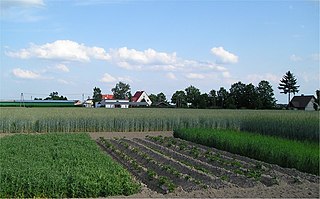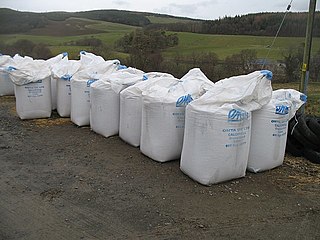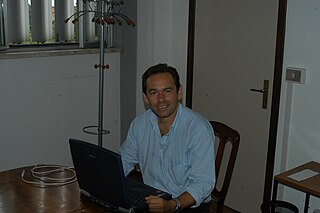Related Research Articles

Agricultural science is a broad multidisciplinary field of biology that encompasses the parts of exact, natural, economic and social sciences that are used in the practice and understanding of agriculture. Professionals of the agricultural science are called agricultural scientists or agriculturists.

Crop rotation is the practice of growing a series of different types of crops in the same area across a sequence of growing seasons. This practice reduces the reliance of crops on one set of nutrients, pest and weed pressure, along with the probability of developing resistant pests and weeds.

Precision agriculture (PA) is a farming management strategy based on observing, measuring and responding to temporal and spatial variability to improve agricultural production sustainability. It is used in both crop and livestock production. Precision agriculture often employs technologies to automate agricultural operations, improving their diagnosis, decision-making or performing. The goal of precision agriculture research is to define a decision support system for whole farm management with the goal of optimizing returns on inputs while preserving resources.

Agronomy is the science and technology of producing and using plants by agriculture for food, fuel, fiber, chemicals, recreation, or land conservation. Agronomy has come to include research of plant genetics, plant physiology, meteorology, and soil science. It is the application of a combination of sciences such as biology, chemistry, economics, ecology, earth science, and genetics. Professionals of agronomy are termed agronomists.

Sustainable agriculture is farming in sustainable ways meeting society's present food and textile needs, without compromising the ability for current or future generations to meet their needs. It can be based on an understanding of ecosystem services. There are many methods to increase the sustainability of agriculture. When developing agriculture within sustainable food systems, it is important to develop flexible business process and farming practices. Agriculture has an enormous environmental footprint, playing a significant role in causing climate change, water scarcity, water pollution, land degradation, deforestation and other processes; it is simultaneously causing environmental changes and being impacted by these changes. Sustainable agriculture consists of environment friendly methods of farming that allow the production of crops or livestock without damage to human or natural systems. It involves preventing adverse effects to soil, water, biodiversity, surrounding or downstream resources—as well as to those working or living on the farm or in neighboring areas. Elements of sustainable agriculture can include permaculture, agroforestry, mixed farming, multiple cropping, and crop rotation.

In agriculture, cover crops are plants that are planted to cover the soil rather than for the purpose of being harvested. Cover crops manage soil erosion, soil fertility, soil quality, water, weeds, pests, diseases, biodiversity and wildlife in an agroecosystem—an ecological system managed and shaped by humans. Cover crops can increase microbial activity in the soil, which has a positive effect on nitrogen availability, nitrogen uptake in target crops, and crop yields. Cover crops may be an off-season crop planted after harvesting the cash crop. Cover crops are nurse crops in that they increase the survival of the main crop being harvested, and are often grown over the winter. In the United States, cover cropping may cost as much as $35 per acre.

A decision support system (DSS) is an information system that supports business or organizational decision-making activities. DSSs serve the management, operations and planning levels of an organization and help people make decisions about problems that may be rapidly changing and not easily specified in advance—i.e., unstructured and semi-structured decision problems. Decision support systems can be either fully computerized or human-powered, or a combination of both.

Liming is the application of calcium- (Ca) and magnesium (Mg)-rich materials in various forms, including marl, chalk, limestone, burnt lime or hydrated lime to soil. In acid soils, these materials react as a base and neutralize soil acidity. This often improves plant growth and increases the activity of soil bacteria, but oversupply may result in harm to plant life. Modern liming was preceded by marling, a process of spreading raw chalk and lime debris across soil, in an attempt to modify pH or aggregate size. Evidence of these practices dates to the 1200's and the earliest examples are taken from the modern British Isles.

Gianni Bellocchi is a researcher in agricultural and related sciences. He is credited with the development of approaches and tools in validation of estimates and measurements. Introduction of fuzzy logic in the context of validation is often considered to be the most significant contribution to the field of model and method validation.
SWAT is a river basin scale model developed to quantify the impact of land management practices in large, complex watersheds. SWAT is a public domain software enabled model actively supported by the USDA Agricultural Research Service at the Blackland Research & Extension Center in Temple, Texas, USA. It is a hydrology model with the following components: weather, surface runoff, return flow, percolation, evapotranspiration, transmission losses, pond and reservoir storage, crop growth and irrigation, groundwater flow, reach routing, nutrient and pesticide loading, and water transfer. SWAT can be considered a watershed hydrological transport model. This model is used worldwide and is continuously under development. As of July 2012, more than 1000 peer-reviewed articles have been published that document its various applications.
The term cropping system refers to the crops, crop sequences and management techniques used on a particular agricultural field over a period of years. It includes all spatial and temporal aspects of managing an agricultural system. Historically, cropping systems have been designed to maximise yield, but modern agriculture is increasingly concerned with promoting environmental sustainability in cropping systems.

Perennial rice are varieties of long-lived rice that are capable of regrowing season after season without reseeding; they are being developed by plant geneticists at several institutions. Although these varieties are genetically distinct and will be adapted for different climates and cropping systems, their lifespan is so different from other kinds of rice that they are collectively called perennial rice. Perennial rice—like many other perennial plants—can spread by horizontal stems below or just above the surface of the soil but they also reproduce sexually by producing flowers, pollen and seeds. As with any other grain crop, it is the seeds that are harvested and eaten by humans.
Wood-free paper is paper created exclusively from chemical pulp rather than mechanical pulp. Chemical pulp is normally made from pulpwood, but is not considered wood as most of the lignin is removed and separated from the cellulose fibers during processing, whereas mechanical pulp retains most of its wood components and can therefore still be described as wood. Wood-free paper is not as susceptible to yellowing as paper containing mechanical pulp. Wood-free paper offers several environmental and economic benefits, including reduced deforestation, decreased energy consumption, and improved waste management. The term Wood-free paper can be rather misleading or confusing for someone unfamiliar with the papermaking process because paper is normally made from wood pulp derived from trees and shrubs. However, wood free paper does not mean that the paper in question is not made from wood pulp but it means that the lignin in the wood fiber has been removed by a chemical process.

A perennial grain is a grain crop that lives and remains productive for two or more years, rather than growing for only one season before harvest, like most grains and annual crops. While many fruit, nut and forage crops are long-lived perennial plants, all major grain crops presently used in large-scale agriculture are annuals or short-lived perennials grown as annuals. Scientists from several nations have argued that perennial versions of today's grain crops could be developed and that these perennial grains could make grain agriculture more sustainable.
"Envirome" is a concept that relates the core of environmental conditions with the successful biological performance of living beings. This concept was created in genetic epidemiology, in which an envirome is defined as the total set of environmental factors, both present, and past, that affect the state, and in particular the disease state, of an organism. The study of the envirome and its effects is termed enviromics. The term was first coined in the field of psychiatric epidemiology by J.C. Anthony in 1995. More recently, use of the term has been extended to the cellular domain, where cell functional enviromics studies both the genome and envirome from a systems biology perspective. In plants, enviromics is directly related to complex ecophysiology, in which the wide environment of the plants, into an omics scale, can be dissected and understood as a mosaic of possible growing factors and the balance of diverse resources available. In ecology, this concept can be related to the Shelford's law of tolerance. The enviromics is conceived as a pillar of the Modern Plant Breeding, capable to connect the design and development of breeding goals concealing it with the agronomic targets for a climate-smart agriculture. It also has the ability to bridge the knowledge gaps between the different levels of systems biology and phenomics in the context of Gene–environment interaction.
Modelling frameworks are used in modelling and simulation and can consist of a software infrastructure to develop and run mathematical models. They have provided a substantial step forward in the area of biophysical modelling with respect to monolithic implementations. The separation of algorithms from data, the reusability of I/O procedures and integration services, and the isolation of modelling solutions in discrete units has brought a solid advantage in the development of simulation systems. Modelling frameworks for agriculture have evolved over time, with different approaches and targets
The Decision Support System for Agrotechnology Transfer (DSSAT) is a set of computer programs for simulating agricultural crop growth. It has been used in over 100 countries by agronomists for evaluating farming methods. One application has been assessing the possible impacts on agriculture of climate change and testing adaptation methods.
Elizabeth Pattey is a principal research scientist at Agriculture and Agri-Food Canada (AAFC) and the leader of the micrometeorology laboratory at the Ottawa Research and Development Centre. Her research supports nationwide improvement in the environmental performance of agriculture, in support of the United Nations' Framework Convention on Climate Change and Canada’s Clean Air Act. She is the co-author for over 80 peer-reviewed scientific publications, and her areas of expertise include trace gas flux measurement techniques, process-based models, and remote-sensing applications.

Carbon farming is a name for a variety of agricultural methods aimed at sequestering atmospheric carbon into the soil and in crop roots, wood and leaves. The aim of carbon farming is to increase the rate at which carbon is sequestered into soil and plant material with the goal of creating a net loss of carbon from the atmosphere. Increasing a soil's organic matter content can aid plant growth, increase total carbon content, improve soil water retention capacity and reduce fertilizer use. Carbon farming is one component of climate-smart agriculture.
BAITSSS is biophysical Evapotranspiration (ET) computer model that determines water use, primarily in agriculture landscape, using remote sensing-based information. It was developed and refined by Ramesh Dhungel and the water resources group at University of Idaho's Kimberly Research and Extension Center since 2010. It has been used in different areas in the United States including Southern Idaho, Northern California, northwest Kansas, Texas, and Arizona.
References
- ↑ "What Are Crop Simulation Models?". Agricultural Research Service, United States Department of Agriculture . Retrieved May 23, 2014.
- ↑ Hoogenboom, Gerrit; White, Jeffrey W.; Messina, Carlos D. (2004). "From genome to crop: integration through simulation modeling". Field Crops Research. 90: 145–163. doi:10.1016/j.fcr.2004.07.014.
- ↑ Chakrabarti, B. "Crop Simulation Models" (PDF). Indian Agricultural Research Institute . Retrieved May 23, 2014.
- ↑ Stöckle, Claudio O.; Donatelli, Marcello; Nelson, Roger (2003-01-01). "CropSyst, a cropping systems simulation model". European Journal of Agronomy. Modelling Cropping Systems: Science, Software and Applications. 18 (3): 289–307. doi:10.1016/S1161-0301(02)00109-0. ISSN 1161-0301.
- ↑ Jones, J. W; Hoogenboom, G; Porter, C. H; Boote, K. J; Batchelor, W. D; Hunt, L. A; Wilkens, P. W; Singh, U; Gijsman, A. J; Ritchie, J. T (2003-01-01). "The DSSAT cropping system model". European Journal of Agronomy. Modelling Cropping Systems: Science, Software and Applications. 18 (3): 235–265. doi:10.1016/S1161-0301(02)00107-7. ISSN 1161-0301. S2CID 16764445.